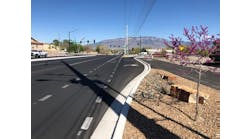Not so long ago, if you had mentioned the possibility of building a $4 million ozone-treatment plant specifically to address storm water pollution in a meeting of environmental professionals, you stood a good chance of being laughed out of the room. But just such a facility is currently under construction in Dana Point, Calif., where it will be used to treat dry-season storm water runoff of up to 1,000 gal a minute from Salt Creek that will then be released into the Pacific Ocean.
Funded completely by a Clean Beaches Initiative grant, the 2,000-sq-ft Salt Creek Ozone Disinfectant Facility is expected to reduce bacterial levels that previously have either forced beach closures or health advisory postings for a significant part of the year.
The Salt Creek facility is just one of several projects that have been built recently that employ water treatment technologies to treat storm water flows, signaling a trend that is likely only to accelerate in the years to come.
Some of these projects have been undertaken to reclaim or preserve recreational resources; others have been implemented to meet increasingly stringent water quality regulations in the U.S. Still others look toward adding to the availability of reclaimed and even potable water resources in communities and regions where these are in increasingly short supply. The treatment technologies have varied considerably, on project context and specific application. Regardless, they represent a sea change in the way storm water will be regarded by the water treatment community.
An arsenal of best-management practices
The Dana Point plant is just one of a handful of water treatment projects scientists and engineers from PBS&J have worked on recently that indicate what may be the initial stages of a major shift in addressing storm water issues and that demonstrate the wide range of approaches this shift is likely to generate.
While the influences driving this change are several and the ramifications likely to be diverse, the main thrust forcing storm water professionals to consider implementing technologies thoroughly familiar to the water treatment community is the current state of regulatory evolution.
In response to the Clean Water Act (established in 1972 and amended in 1977) and the National Pollution Discharge Elimination System program, environmental professionals have worked to identify and address real and potential sources of water pollution, focusing primarily on mitigating the effects of discharges that could be traced directly to specific “point” sources. This work led to understanding that only a very small percentage of all storm water pollutants could be attributed to point sources and that strategies addressing non-point sources would be required to reduce the majority of pollutants.
Thus began the development of an array of best-management practices (BMPs) focused on the principles of watershed ecology. BMPs are based on leveraging biological resources in structural and non-structural strategies to act on and manage storm water flows to reduce pollutant levels.
TMDL regulation
The recent shift in regulatory focus by the U.S. Environmental Protection Agency (EPA) is likely to render much of the storm water BMP approach obsolete. This is because measurement strategies will now draw attention away from the sources of pollution and toward their verifiable effects on specific bodies of water in the form of Total Maximum Daily Load (TMDL) levels.
A TMDL is a calculation of the maximum amount of a pollutant that a water body can receive each day and still meet water quality standards and an allocation of that amount to the pollutant’s sources.
Intended to provide federal overseers with sharper regulatory teeth, the shift to TMDL enforcement is also likely to increase the influence of local environmental groups pressing for faster and more dramatic solutions to pollution problems. Ultimately, TMDL regulation will enforce tighter deadlines for improvement of pollution problems at specific sites than the vast majority of previously developed storm water BMPs are capable of meeting.
In addition, two other social pressures are likely to affect the approach to storm water management.
First is the pressure on local governments to provide recreational resources to draw populations and add to tourism incomes. The extent of the challenges encountered here would be hard to understate. The EPA has estimated that 40% of all U.S. waters are still too polluted for swimming, fishing or the support of aquatic life, while a nationwide survey in 2000 indicated that 85% of all beach closures in the continental U.S. could be attributed to elevated bacteria counts.
In a recent project, PBS&J worked closely with officials from Encinitas, north of San Diego, Calif., to address health concerns at the coastal city’s popular Moonlight Beach, which attracted more than 2.5 million visitors in 2000 despite 93 beach closings due to high bacteria counts. Encinitas officials had identified the main source of beach contamination as runoff from the Cottonwood Creek watershed, which covers 2,000 acres in the heart of the city.
Several years of source identification, upstream BMPs and stricter enforcement measures, however, failed to reduce beach closings. The solution was construction of a 150 GPM UV disinfection system. Effluent, in measurements from September 2002 to November 2003, indicated that UV treatment reduced turbidity by 75% and virtually eliminated all coliform bacteria.
The second social pressure is the rapidly growing population in regions, especially the southwestern and western U.S., where water supplies for agriculture and drinking water are already in short supply. Treated storm water flows may be a viable means for amplifying the sources of these supplies.
A future of increased collaboration
Not all storm water treatment programs will be forced to rely on the latest generations of technology, either. Traditional water treatment technologies are being used in Florida to treat storm water.
PBS&J worked with officials of Brevard County on densely populated Merritt Island, just south of Cape Canaveral, Fla., to retrofit pre-existing storm water discharge into the Indian River Lagoon, a Florida Outstanding Water Body.
The solution was a 20-acre, $3 million treatment facility and detention pond that injects alum at three influent locations to bring the storm water into regulatory compliance. This treatment scheme ultimately required approximately 40-60% less land area than a conventional wet-detention treatment system while providing comparable or better results.
Florida population growth, agricultural needs and environmental management have put a premium on available water supplies. PBS&J has been working closely with Sarasota County, Fla., officials since 2000 to establish an aquifer storage and recovery (ASR) system for the North County Reuse Service Area in which storm water is treated prior to injection into the aquifer.
The project began with a feasibility and well-siting study that recommended location at the Central County Water Reclamation Facility as well as treatment-system upgrades to assure higher treatment efficiency of reclaimed water prior to storage. The Sarasota ASR project demonstrates technology that will allow communities to store storm water in the ground for future water-supply needs such as drinking water, irrigation and industrial uses.
This project, along with the others that PBS&J has worked on, indicate the beginning of a long-term trend, obscuring the previously sharp line drawn between storm water management practices and state-of-the-art water-treatment technologies. The outcome of this shift in professional activities should benefit all concerned.
The ultimate benefit will be the design and construction of multi-functional facilities that provide more efficient jurisdictional treatment at lower overall costs. They will also provide potential sources for reclaimed and even potable water supplies.


